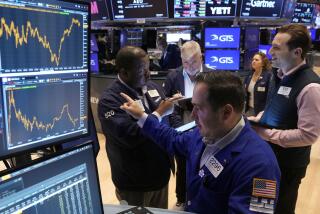Wall St. Surprised by Sudden Rise in Short-Term Rates
Interest rates were expected to rise initially if Bill Clinton won the presidency, but the sharp jump in shorter-term rates in recent weeks has already far exceeded many forecasts. That’s worrying more than a few folks on Wall Street--though it may cheer average savers.
The discount rate on one-year Treasury bills has surged from 2.84% at the start of the month to 3.44% on Tuesday. The six-month T-bill rate has leaped from 2.85% to 3.24% in the same period. Much of the increase in shorter-term rates has occurred just in the last two days.
Many investors had figured that an impending Clinton victory would send longer-term interest rates soaring on the belief that a Democratic President and a Democratic Congress would mean higher inflation down the road. You know the recipe: More federal spending equals more inflation, equals higher interest rates.
But while long-term rates have indeed jumped in recent weeks, they’ve been outdistanced by shorter rates. For example, the 0.60-point rise in one-year T-bill rates since Oct. 1 compares to a 0.32-point rise in 30-year T-bond yields, which have risen from 7.32% to 7.64% in the period.
What’s with short-term rates? David Jones, economist at bond dealer Aubrey G. Lanston & Co. in New York, says Wall Street has simply been taken by surprise by the Federal Reserve’s reluctance to cut short rates further to help the ailing economy.
“An awful lot of people were speculating on that” in September, Jones notes. In the process they rushed into short-term securities on the assumption of a quick profit once the Fed cut.
As it has become clear that the Fed doesn’t see the need to cut again, shocked speculators have merely brought short rates back up to where they perceive the Fed wants them to be, Jones says. And as usual on Wall Street when mistakes are made, the correction has come quickly.
The significance here is that trends in short rates matter most to individual investors. All year long, investors have fled low-yielding short-term bank savings certificates and money market accounts for the perceived higher returns in stock and bond mutual funds.
If bank CD rates suddenly begin to rise--and dramatically--the Niagara-like money flow to stock and bond funds is certain to shut off. And that could undermine those markets in 1993.
So far, banks and S&Ls; have been slow to boost their CD rates to match higher short-term Treasury yields. As of last week, the national average yield on six-month CDs was still falling, dropping to 3% from 3.02% a week earlier, says Robert Heady, publisher of Bank Rate Monitor in North Palm Beach, Fla.
This week, however, Heady sees tentative signs of a turn in CD yields, though he cautions that it is too early to project a trend. Nonetheless, he notes that a few major banks nationwide have raised their rates on six-month CDs in recent days: First National Bank of Chicago, for example, boosted its rate from 2.73% to 2.84%. Pittsburgh’s Mellon Bank went from 2.70% to 2.80%.
How much higher can short rates go? Because the Fed is keeping its benchmark short rates--the discount rate and the federal funds rate--at or near 3%, the October jump in Treasury bill rates should be almost finished, most economists say. “I think we’re close to where we’ll be holding on those rates,” says Jones. That should also keep a lid on short-term bank CD yields and money market account yields.
It’s also worth noting that, despite the increase in short rates, they’re only back to August levels.
Still, some Wall Streeters caution that perception may play a bigger role with short rates than reality in the weeks ahead. If investors perceive that a Clinton Administration will succeed in boosting economic growth sooner than later, short-term rates could rise quickly to levels that would reflect that new pace of growth. Just as investors speculated too heavily on a Fed rate cut a few weeks ago, they may soon speculate too heavily on a robust economy--at the expense of short-term interest rates.
“This market isn’t being pressured so much by transactions (of securities) as it is by a change in thinking,” says Robert DiClemente, economist at Salomon Bros. in New York.
Rates on the Rise
How rates on some Treasury securities have jumped since Oct. 1.
Annualized rate: Treasury security Oct. 1 Tues. Change 3-month bill 2.69% 3.01% +0.32 6-month bill 2.85% 3.24% +0.39 1-year bill 2.84% 3.44% +0.60 5-year note 5.26% 5.92% +0.66 30-year bond 7.32% 7.64% +0.32
More to Read
Inside the business of entertainment
The Wide Shot brings you news, analysis and insights on everything from streaming wars to production — and what it all means for the future.
You may occasionally receive promotional content from the Los Angeles Times.










